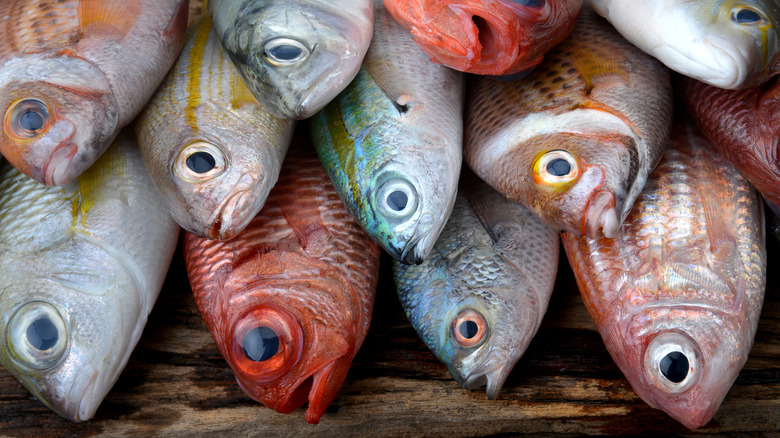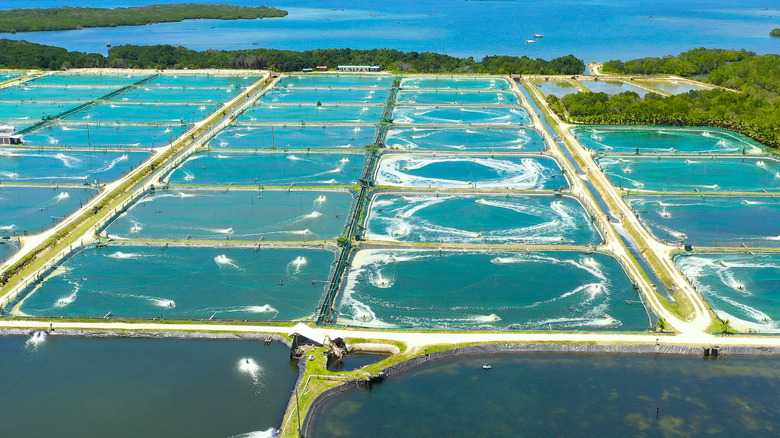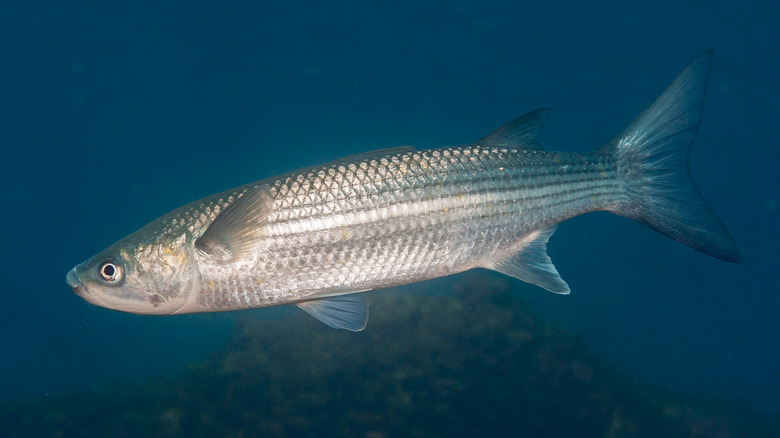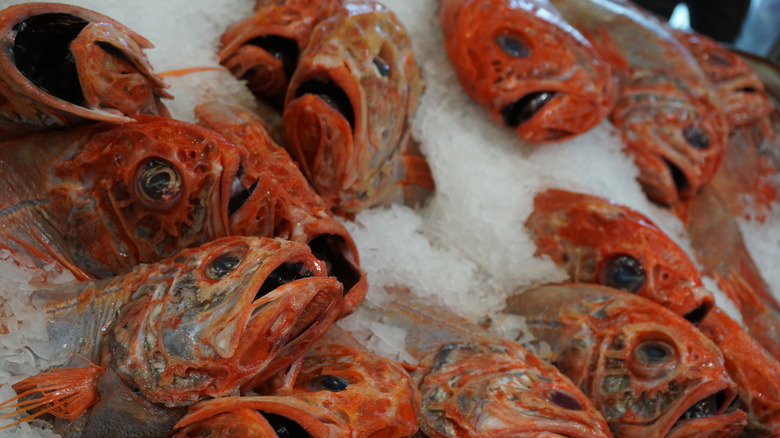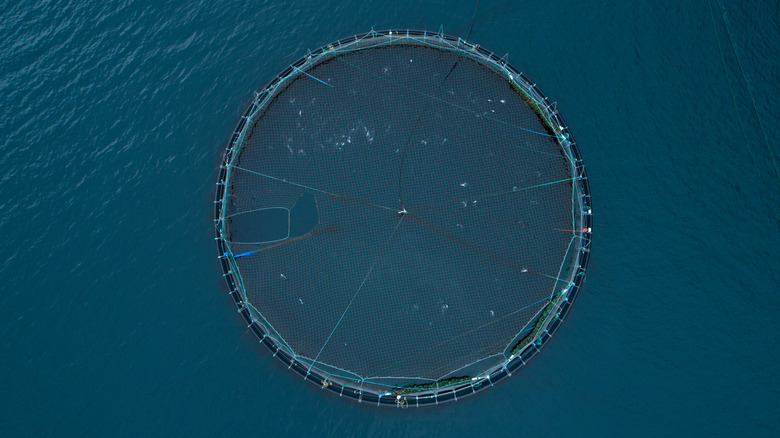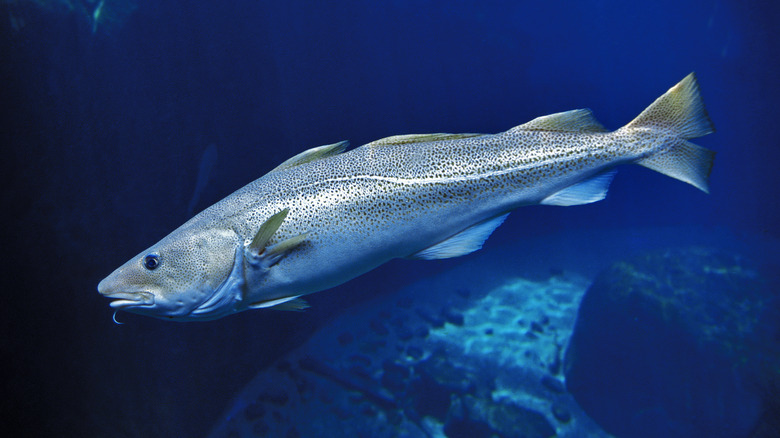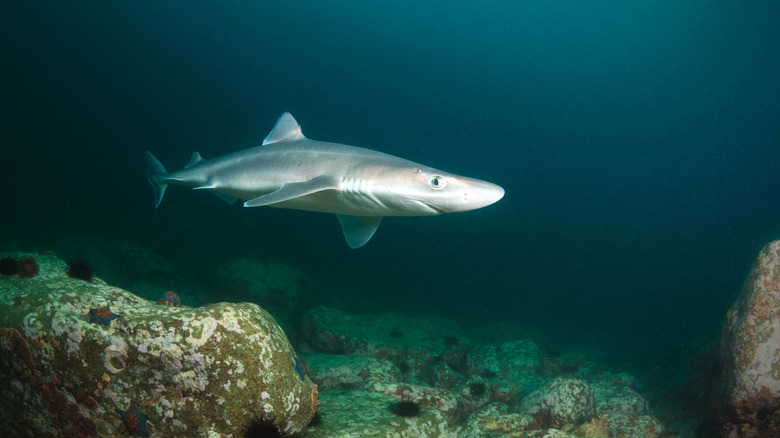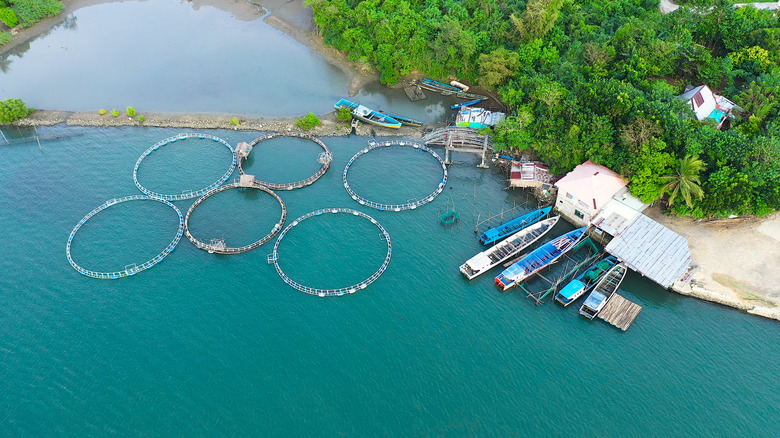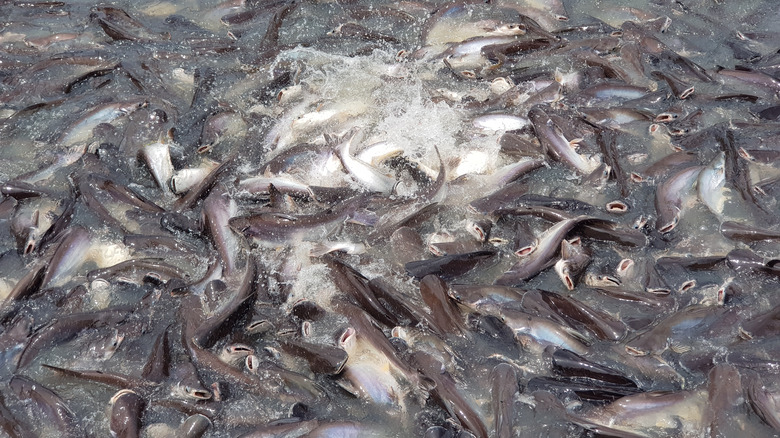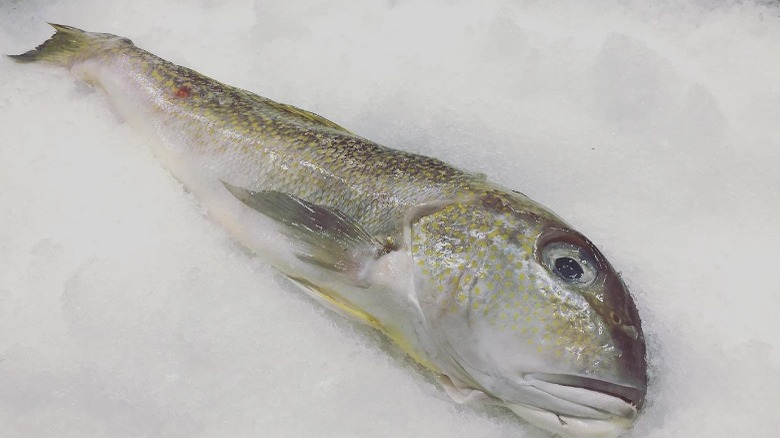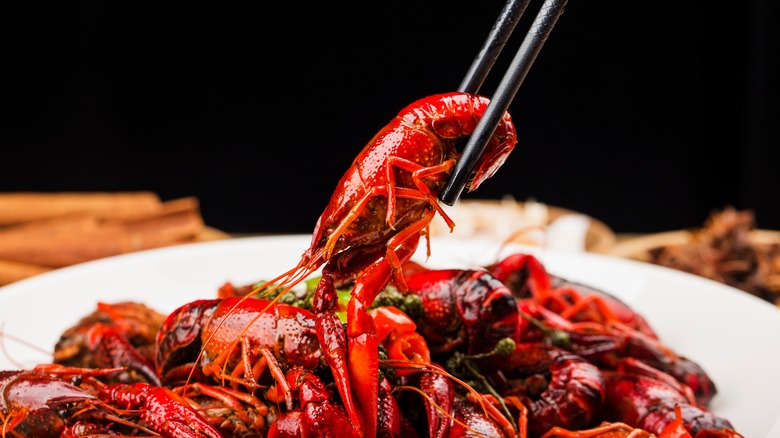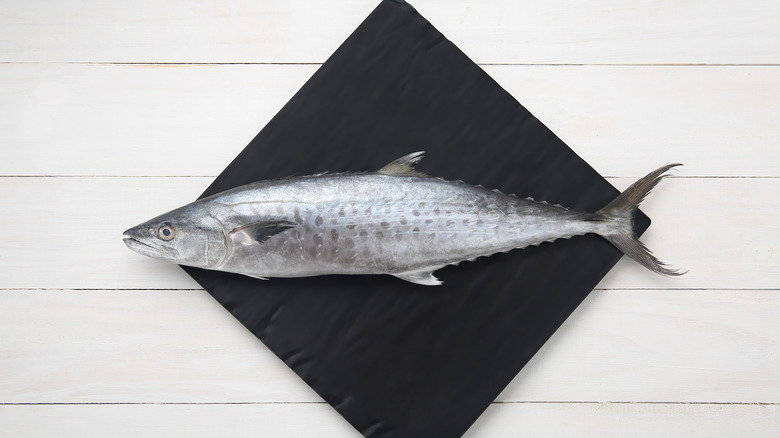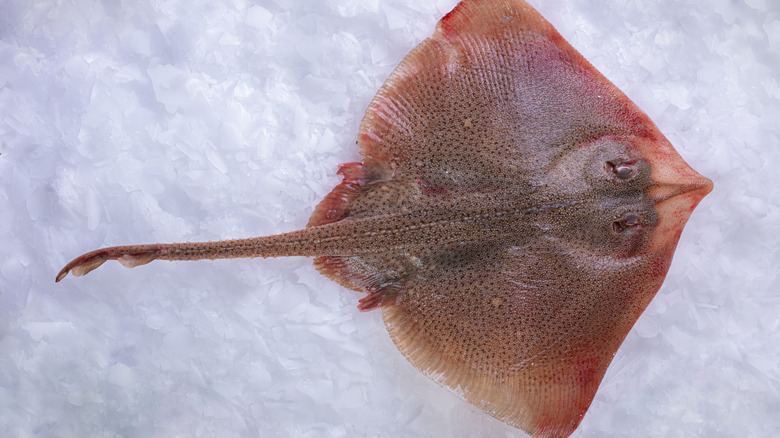12 Cheap Fish You Should Absolutely Never Eat
It's no secret that seafood can bring a whole lot of good into your daily diet. Pitmann Seafoods argues that not only does fish provide comparable protein to other meats, but does so with less fat. Additionally, fish contain many vital nutrients, minerals, and omega-3 fatty acids. It's no surprise that popular diets like the Mediterranean diet utilize fish as a nutritious cornerstone.
But, there are many structural and environmental factors to keep in mind when selecting fish, according to the BBC. Many already know, for example, that pregnant women should limit their fish consumption, mainly due to different mercury levels in some large fish species. Fish accumulate more mercury the older and the bigger they are, so some species will pose more risks than others, both to expecting mothers and general consumers.
Another growing concern is waste chemicals from past decades that may pollute the environment in which fish swim. Finally, there are some fish that are actively threatened by overfishing. While opting for fish can make for a meaningful change to your diet, it should be an informed decision. There are, simply put, some fish where the benefits are outweighed by the drawbacks. Here are some cheap varieties of fish you should avoid whenever possible.
Farmed shrimp
It's no secret that Americans love shrimp. In 2019, people in the United States ate an estimated 1.5 billion pounds of shrimp, or about 4.4 pounds per person (via New York Times). It's not hard to understand how this flavorful shellfish became so popular. The shrimp's popularity is also due to its low price point, making it all the easier to find and serve up for dinner.
According to the New York Times and the World Wildlife Fund, cheap shrimp got that way due to the many aquaculture farms that breed them. Most are located in Southeast Asia and provide a whopping 55% of the global shrimp supply.
Ideally, the shrimp are bred in good conditions, but the reality is more murky. Some farms are pristine and ethically managed, while others are overcrowded, employ unethical practices, and raise major environmental concerns. Shrimp farms can pollute surrounding water systems with chemicals, threaten local wild shrimp populations, and encourage monocultures. Furthermore, it's nearly impossible to trace shrimp back to the farm they came from (via New York Times).
Grey mullet
Grey mullet is an increasingly popular fish from England, that can be found at its cheapest for less £9 for two fillets (via The Devon Fishmonger). The fish was once considered less than appetizing, perhaps given its name and proclivity to feed on sewer waste (via Angling Trust). But, just as the mullet hairstyle has come back into fashion, it seems that the grey mullet fish is enjoying a resurgence. With its bold flavor, this species works well as a cheap stand-in for sea bass.
However, the Angling Trust is quick to raise a red flag. According to the chairman of the National Mullet Club, grey mullet are in a precarious situation. Two factors are challenging the current grey mullet population. First, grey mullet are often caught as a by-catch offshore. This is especially problematic because, when grey mullet are out in open-waters, they are most likely spawning. Secondly, young female grey mullet that have not reached maturity are regularly caught and sold, meaning they're taken out before they can breed new mullet. This could spell disaster for the fish's ability to replenish its numbers. The Angling Trust notes that already it's seeing a decline in the local grey mullet population. So, when it comes to the grey mullet, this is a trend that's best left alone.
Orange roughy
"Orange roughy" was actually a clever rebranding of the less palatable "slimehead" name (via Seafood Source). The rebranding must have worked, as orange roughy became a kitchen staple in Australia by the 1970s (via Good Fish Bad Fish). It has a mild flavor, good flake, and holds up nicely when cooked. It can still be purchased for around $11.50 per serving (via Wholey). But, before digging in to this brightly colored fish, it's best to think twice.
The orange roughy is a bottom-dwelling fish that does not reproduce often, and the average age of caught orange roughy averages between 30 to 50 years in age (via Seafood Source). This makes the orange roughy extremely susceptible to overfishing. Additionally, SFGate points out that, due to the average fish's advanced age, an orange roughy fillet can have high levels of mercury.
Furthermore, as noted by Good Fish Bad Fish, the bottom trawling fishing techniques used to harvest orange roughy are extremely disruptive to fragile marine ecosystems. Finding it can be misleading, too, as orange roughy is often intentionally mislabeled and sold as "deep sea perch."
Farm-raised Atlantic salmon
Farmed salmon is a bit controversial. This reputation of this fish, though it's cheaper and therefore more accessible than its wild cousin, is marred by the argument that it is more prone to disease, flooded with chemicals, and full of harmful metals. The Washington State Department of Health assures consumers that farm-raised salmon have comparable levels of toxins and metals to wild salmon, however. Plus, this fish really is easier on the wallet, as farm-raised salmon comes at a much lower price than wild varieties (via Niceland Seafood).
While this may sound like the perfect trade-off, there are still major environmental implications to keep in mind. According to the BBC, salmon farms deserve just as much close attention as more closely-examined chicken operations, though the current level of scrutiny might be wanting. Consider the mortality issue. Around 20% of farmed salmon stock die for a variety of reasons, including parasites, disease, and the effects of chemical treatments. These same chemicals can leach out into surrounding waters and into the wider environment, while parasites that proliferate in farmed populations can affect wild salmon. While farmed salmon is markedly cheaper, many have still concluded that wild salmon is the more worthwhile choice for the environment.
Atlantic cod
Cod has long been favored because of its mild flavor, firm texture, and flakiness (via Chef's Resources). The two cod stocks, or populations, of Maine have long satisfied American cravings for this fish. In fact, the name Cape Cod is said to have come from the once abundant cod population that lived off the Massachusetts coast, according to NOAA.
But cod stocks were once so mismanaged and overfished that harsh restrictions had to be taken to ensure the species' survival (via NPR). However, there is some good news: At the beginning of 2022, the 2019 class of cod stock in Maine was especially healthy. In a few years' time, the cod population and its fishing industry may be back up to par.
However, the Conservation Law Foundation advises us not to count our (fish) eggs before they hatch. A new factor that could greatly affect the fish is the changing climate. The Gulf of Maine is one of the fastest-warming bodies of water on the planet, a factor that could greatly affect this cold-water fish. For the time being, perhaps cod are better left alone.
Rock salmon
Rock salmon, also known as spiny dogfish, isn't really a fish at all. Instead, as CNN reports, it's actually a species of shark. Despite the confusion, spiny dogfish has a flavor profile that's more similar to white fish, with mild, firm, and flaky flesh (via SeafoodSource).
Spiny dogfish are incredibly cheap and can sell for as little as $1.84 a pound, according to Selina Wamucii. While spiny dogfish hasn't exactly made waves in the United States, it's commonly served as fish and chips in England (via The Independent). By 2019, as much as 95% of the spiny dogfish population in the Northeast Atlantic had been depleted. The U.S. stepped in as a major supplier to Europe, according to the Massachusetts Division for Marine Fisheries.
While the spiny dogfish is still plentiful in U.S. waters, the species is extremely susceptible to overfishing as it takes a long time to mature and reproduce (via CNN). Furthermore, mislabelling spiny dogfish as rock salmon promotes dishonesty and unethical business practices. So, next time you're looking for fish and chips in the States or abroad, be sure you're consuming a different species.
Farm-raised tilapia
Tilapia is one of the most preferred fish among Americans, which LiveStrong credits to its mild flavor and low price point. While LiveStrong dismisses claims that tilapia are unhealthy and sensational, it does hone in on the realities of farm-raised tilapia. About 50% of the world's tilapia and around 73% of tilapia sold in the U.S. is sourced from Chinese fish farms.
Farmed fish aren't necessarily bad, according to the New York Times. Tilapia in particular responds well to farmed conditions and can help provide relief to overburdened wild populations. However, the diet farmed tilapia are subjected to doesn't allow them to develop the extremely beneficial omega-3 fatty acids that fish are known and praised for. LiveStrong even claims that some tilapia farms may feed the fish primarily feces, which certainly isn't conducive to a healthy, hearty animal.
Additionally, fish that are fed hormones and antibiotics may have adverse effects on the human body that further negate an otherwise "healthy" option. The best option is to avoid farmed tilapia altogether, though that's not easy to do given the market for cheap tilapia. Still, it may be better for both health and the environment to opt for a more local and transparent choice.
Swai fish
Swai fish is a whitefish that is considered neutral enough to satisfy even those who might otherwise turn their nose up to fish (via Healthline). This is a Vietnamese species that has only grown in popularity in the States over the last couple of years, where it is commonly marketed as basa or panga. At one point, it was even sold as "imported catfish", perhaps to better help with sales through a more familiar name.
While often cultivated in the extremely polluted Mekong Delta, concerns about this fish tend to focus more on farming practices. Earth.com notes that there are serious concerns surrounding the environmental impact of fish farming practices that flush antibiotics, waste, and other chemicals into nearby waters, disrupting the already fragile ecology of the delta. Providing too many antibiotics to fish may also encourage the growth of antibiotic-resistant bacteria.
To top it all off, swai fish contain considerably less omega-3 fatty acids due to their typical feed (via Healthline). According to Earth.com, the less than stellar quality of feed and extremely close quarters of fish pens also heighten the risk of disease. It's also often mislabeled (both unintentionally and on purpose) and sold in place of more expensive catches like sole or grouper.
Tilefish
It's no secret that tilefish is not the best option in the menu or at the grocery store. Sure, there are some benefits, like its high levels of vitamin B12 and omega-3 fatty acids (via Can Dogs Eat It). Tilefish is also mild in flavor, to the point where Fish Choice compares it to that of lobster or crab. Smaller cuts of tilefish even have the added bonus of being a very economical choice. But, all these benefits come with a major caveat: tilefish can have an extremely high mercury content.
Even if the fish is often sold as small fillets, it's actually a large, predatory animal. Its mercury levels are heightened when it eats other fish. The Environmental Defense Fund claims that both mid-Atlantic and Gulf of Mexico-based tilefish therefore have elevated levels of mercury.
Both Fish Choice and the Environmental Defense Fund go so far as to suggest that women (pregnant or not) and children should never eat this fish, and even men should only consume one portion per month. That's because high mercury exposure can adversely affect the nervous system, especially that of unborn fetuses (via Washington State University). For many, the price point and flavor simply isn't worth the risk.
Imported crayfish
Crawfish, crawdads, and crayfish are all different names for the same animal, according to Grammarly. While the shellfish may be deeply connected to the Deep South and Cajun cuisine in particular, nowadays the scope of this delicacy is much bigger. Since the '90s, China has been a major exporter of crawfish, specifically peeled crawfish tail, to the United States (via New York Times).
According to the New York Times, Chinese-exported crawfish were able to undercut domestically caught crawfish by around a half, providing a global battlefield for a once regional delight. Today, it still isn't hard to find Chinese-bred crawfish for as little as .45 per pound (via Made-in-China). Meanwhile, the pandemic, rising demand for crawfish inland, and other factors contributed to domestic crawfish blooming to $1.50 per pound, as per Texas Monthly.
Imports may be cheaper, depending on the year, and taste virtually the same as inland crawfish, yet somewhat pricier American-bred crawdads may be the better environmental choice. While purchasing crawdads may not be a "local" buy, investing in national goods assures that the product meets not only U.S. standards and quality control, but also promotes national delicacies (via Green Business Bureau). Additionally, the carbon footprint of inland crawfish is sure to be less than that of imports.
King mackerel
King mackerel, despite its royal name, can be found as little for $7 a pound (via Wild Seafood Market). According to many, what really makes this particular fish stand out is its amazing texture. Yet, as SeaGrant Louisiana notes, the strong taste of king mackerel can turn people off. But there is more than just texture or flavor to consider when it comes to this fish.
As SeaGrant Louisiana notes, king mackerel are extremely large fish that weigh between 15-50 pounds, although individual fish weighing up to 100 pounds have been reported in the wild. These fish don't just magically reach this size. King mackerel are predators that feed on much smaller fish, a major contributing factor to the mackerel's high mercury content.
Seafood Authenticity and Traceability compares the mercury levels of the king mackerel to that of more well-known offenders like swordfish and shark. As per SeaGrant Louisiana, king mackerel's mercury level tests highest amongst all Gulf fish, and advisories have been issued in surrounding states against consuming it. This fish species is certainly not recommended for women and children, but really anyone should think twice before indulging.
Skate fish
Skate fish are relatives of the sting ray; certainly, the family resemblance is almost impossible to miss. While these beauties might not be the first thing that comes to mind when thinking of seafood, their flavor profile has been praised, drawing comparisons to scallops with an extremely chewy texture (via Chef's Resources). The skate's price point also remains extremely low. In 2022, skate fish were available at wholesale for as little as $1.33 per pound (via Selina Wamucii).
Consumers should still exercise caution around skates, however. The Guardian reported that the common skate had nearly disappeared from the North Sea in 2002 due to trawling, a means of fishing that involves dragging nets across the seabed and which has proved to be highly disruptive to many bottom-feeding species.
What's worse is the fact that most skate species are what University of Miami refers to as a "data-poor" species, meaning little is known about their population history, life span, and breeding habits, which makes sustainability measures hard to implement. In the meantime, many skate populations remain in a precarious situation and need to be protected. There are a few species that have been reported okay to eat, like the California skate or longnose skate. Yet skate species like the baja skate or longnose skate from British Columbia are in critical condition.
